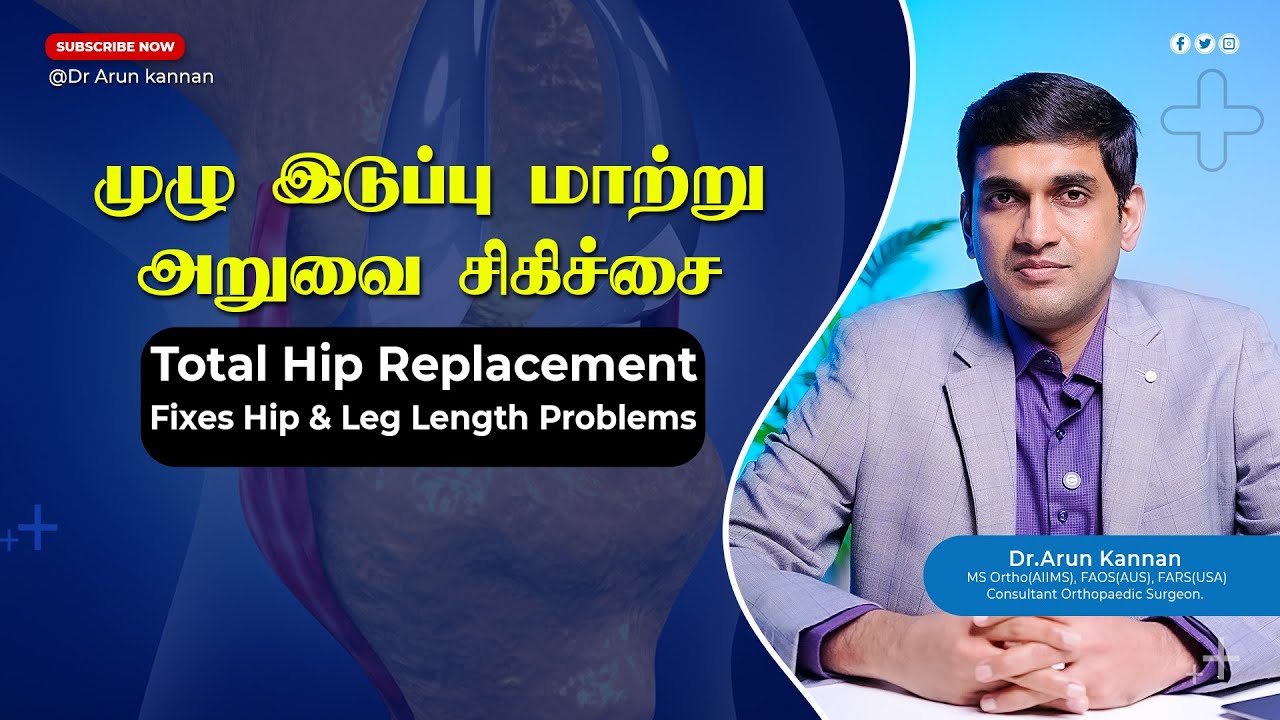 3 August, 2025
3 August, 2025
Total Hip Replacement: Solve Hip Pain & Limb Shortening | Dr. Arun Kannan | Chennai Ortho
Hip pain and leg length discrepancy can significantly impact a person’s quality of life, limiting mobility and causing discomfort. Total hip replacement surgery has emerged as one of the most successful orthopedic interventions to address these issues. In this comprehensive article, we will delve into the causes behind hip joint problems, the reasons for leg shortening, and how total hip replacement not only relieves pain but also corrects limb length discrepancies. Drawing from the expertise of Dr. Arun Kannan, an experienced orthopedic surgeon from Chennai, we will also explore the advances in surgical techniques, including robotic assistance, that have refined the precision of hip replacement surgeries.
Table of Contents
- Understanding Hip Joint Problems and Their Impact
- Total Hip Replacement: A Solution to Hip Pain and Limb Shortening
- Challenges in Correcting Limb Length Discrepancy
- Advances in Hip Replacement Surgery: The Role of Robotic Assistance
- Summary: The Importance of Balanced Hip Replacement Outcomes
- Frequently Asked Questions (FAQs)
- Contact and Further Information
Understanding Hip Joint Problems and Their Impact
The hip joint is a ball-and-socket joint that plays a crucial role in supporting body weight and facilitating movement. When this joint is damaged due to various reasons, patients often experience pain, stiffness, and difficulty walking. One common consequence of hip joint damage is limb shortening, where one leg becomes shorter than the other, affecting gait and balance.
Common Causes of Hip Joint Damage
Several conditions can lead to deterioration of the hip joint, resulting in pain and functional impairment:
- Avascular Necrosis (AVN): This condition, which is quite common in India, involves the loss of blood supply to the femoral head (the ball part of the hip joint), leading to bone death and collapse. AVN can severely damage the hip joint, causing pain and shortening of the affected limb.
- Post-Traumatic Arthritis: Injuries to the hip joint, such as fractures or dislocations, can lead to arthritis over time. This form of arthritis develops due to damage sustained after trauma and can cause joint degeneration and limb shortening.
- Childhood Hip Disorders: Some individuals experience hip joint issues from a young age, such as developmental dysplasia of the hip (DDH) or childhood dislocations. These conditions can interfere with the normal growth and development of the hip joint, resulting in limb length discrepancies in adulthood.
- Other Causes: Autoimmune disorders like ankylosing spondylitis and other inflammatory conditions can also affect the hip joint, leading to pain and functional limitations.
How Hip Joint Damage Causes Limb Shortening
When the hip joint is damaged, several factors can contribute to the shortening of the affected leg:
- Bone Collapse or Deformity: In avascular necrosis or post-traumatic arthritis, the femoral head can collapse or deform, reducing the effective length of the leg.
- Growth Disturbances: Childhood hip problems can impair normal bone growth, leading to a shorter leg on the affected side.
- Joint Space Narrowing: Arthritis can cause the cartilage in the hip joint to wear away, reducing joint space and contributing to limb length discrepancy.
- Fracture Malunion: Improper healing of hip fractures can result in shortening of the femur.
These changes not only cause pain but also disrupt a person’s gait, causing imbalance. Patients often walk with a limp, and may feel discomfort due to the difference in leg lengths.
Total Hip Replacement: A Solution to Hip Pain and Limb Shortening
Total hip replacement (THR) surgery involves replacing the damaged parts of the hip joint—the acetabulum (socket) and the femoral head (ball)—with artificial components. This procedure has been described as the “operation of the century” due to its high success rate in relieving pain and restoring mobility.
Goals of Total Hip Replacement
The primary objectives of THR are twofold:
- Pain Relief: Removing the damaged joint surfaces and replacing them with smooth, artificial components eliminates the source of pain.
- Correction of Limb Length Discrepancy: By restoring the anatomy of the hip joint, the surgeon aims to equalize the length of both legs, improving balance and gait.
Achieving both goals is essential for a successful outcome. While pain relief is the most immediate benefit, restoring leg length equality significantly enhances the patient’s ability to walk comfortably and reduces the risk of long-term complications such as lower back pain or joint strain.
How Limb Length Discrepancy Occurs in Hip Problems
In many hip joint disorders, the affected leg becomes shorter due to structural changes in the bone and joint. For example, in congenital hip dislocation, the socket may be shallow or malformed, causing the ball to sit higher than normal, which shortens the leg. Similarly, avascular necrosis leads to collapse of the femoral head, effectively reducing leg length.
During total hip replacement, the surgeon has the opportunity to correct these discrepancies by carefully positioning the artificial components. Adjusting the height of the femoral head and the depth of the socket can help restore the leg to its proper length.
Technical Aspects of Length Correction in Hip Replacement
Length correction during THR is a delicate balance. Over-lengthening the leg can cause nerve tension and discomfort, while under-correction leaves the patient with imbalance and limp. Surgeons use various techniques to measure and adjust leg length during surgery:
- Preoperative Planning: Detailed imaging studies such as X-rays help assess the degree of shortening and plan the surgery accordingly.
- Intraoperative Measurement: Surgeons use anatomical landmarks and measurement tools to compare leg lengths during the procedure.
- Component Positioning: The position of the acetabular cup and femoral stem can be adjusted to optimize leg length and joint stability.
In some cases, leg length discrepancy after surgery may be minor (often less than 1 cm) and well tolerated by the patient. However, discrepancies greater than 1.5 to 2 cm may require shoe lifts or orthotic aids to improve comfort and gait.
Challenges in Correcting Limb Length Discrepancy
While total hip replacement offers a chance to restore leg length, it is not always straightforward. Several factors complicate this correction:
- Severe Deformities: In patients with long-standing hip problems, especially those starting in childhood, the bones may have developed abnormally, making equalization challenging.
- Soft Tissue Contractures: Tight muscles and ligaments around the hip can limit how much the leg length can be increased during surgery without causing complications.
- Risk of Nerve Injury: Excessive lengthening can stretch nerves, leading to numbness or weakness.
Because of these challenges, surgeons aim for the best possible correction within safe limits, often accepting a small residual difference that can be managed postoperatively.
Postoperative Expectations and Gait Improvement
After surgery, patients usually experience significant pain relief and improved mobility. The correction of leg length discrepancy helps restore balance, allowing a more natural gait. However, full recovery takes time:
- Initial Phase: Patients may notice some residual limp or imbalance as they adapt to the changes.
- Physical Therapy: Rehabilitation focuses on strengthening muscles, improving joint flexibility, and retraining walking patterns.
- Long-Term Outcomes: With proper care, most patients achieve near-normal leg length equality and comfortable walking.
In cases where leg length discrepancy remains noticeable, shoe lifts or customized orthotics can help improve gait and reduce discomfort.
Advances in Hip Replacement Surgery: The Role of Robotic Assistance
Technological advancements have revolutionized the precision of total hip replacement surgeries. Robotic-assisted surgery allows surgeons to plan and execute procedures with millimeter-level accuracy, enhancing outcomes related to leg length correction and joint alignment.
How Robotic Technology Improves Surgery
- Preoperative 3D Planning: Using advanced imaging, surgeons create a detailed 3D model of the patient’s hip, enabling precise planning.
- Intraoperative Guidance: The robotic system assists in positioning the implant components exactly as planned, minimizing human error.
- Fine Adjustments: Surgeons can adjust the femoral head height and socket placement with high accuracy to balance leg lengths.
- Real-Time Feedback: The system provides continuous data, helping the surgeon make informed decisions during the procedure.
Compared to conventional hip replacement, robotic surgery significantly reduces the risk of leg length discrepancy and improves joint stability, leading to better patient satisfaction.
Case Example: Correcting Limb Shortening with Robotic Hip Replacement
Consider a patient with avascular necrosis in the right hip, resulting in a noticeably shorter right leg. Preoperative X-rays reveal the extent of shortening and joint damage. Using robotic-assisted surgery, the surgeon is able to precisely place the implants, restoring the right leg length to match the left. Postoperative evaluation shows both legs at equal levels, and the patient experiences significant pain relief and improved walking ability.
Summary: The Importance of Balanced Hip Replacement Outcomes
Total hip replacement surgery is a powerful tool to alleviate hip pain and correct limb shortening caused by various hip joint disorders. Achieving leg length equality is crucial for restoring natural gait and preventing secondary complications. With advances in surgical techniques and robotic assistance, surgeons can now perform these corrections with remarkable precision.
Patients considering hip replacement should discuss with their orthopedic surgeon the goals of surgery, including pain relief and leg length correction, and understand the realistic expectations for recovery. Rehabilitation and follow-up care play vital roles in maximizing the benefits of the procedure.
Frequently Asked Questions (FAQs)
1. What causes leg shortening in hip joint problems?
Leg shortening often results from damage to the femoral head or acetabulum due to conditions such as avascular necrosis, arthritis, childhood hip disorders, or fractures. These can cause bone collapse, deformity, or impaired growth, leading to a shorter leg.
2. Can total hip replacement completely fix leg length discrepancy?
While total hip replacement aims to equalize leg lengths, complete correction may not always be possible due to anatomical and soft tissue limitations. However, most patients achieve significant improvement, and minor differences can be managed with shoe lifts.
3. How does robotic-assisted surgery improve hip replacement outcomes?
Robotic-assisted surgery allows for precise planning and placement of implants, enabling surgeons to restore leg length and joint alignment with millimeter accuracy. This reduces the risk of complications and improves patient satisfaction.
4. What is the typical recovery time after total hip replacement?
Recovery varies by individual but generally involves several weeks of rehabilitation. Patients often begin walking with assistance within days and can expect substantial improvement in pain and mobility within a few months.
5. Are there risks associated with correcting leg length during hip replacement?
Yes, excessive lengthening can stretch nerves leading to numbness or weakness. Surgeons carefully balance correction to avoid these risks while maximizing functional outcomes.
6. What should I expect in terms of gait after hip replacement?
Most patients experience improved gait with less limp after the surgery. Physical therapy helps retrain walking patterns to adapt to the new joint and leg length.
Contact and Further Information
If you have hip pain or suspect limb shortening, it is important to consult an orthopedic specialist for evaluation. Experienced surgeons like Dr. Arun Kannan at Apollo Hospitals, Chennai, provide expert care including advanced robotic-assisted total hip replacement to restore function and quality of life.
For appointments or inquiries, contact: 93604 38720
Address: Apollo Hospitals, Chennai
Empower yourself with knowledge and take the first step towards a pain-free, balanced life through total hip replacement surgery.

